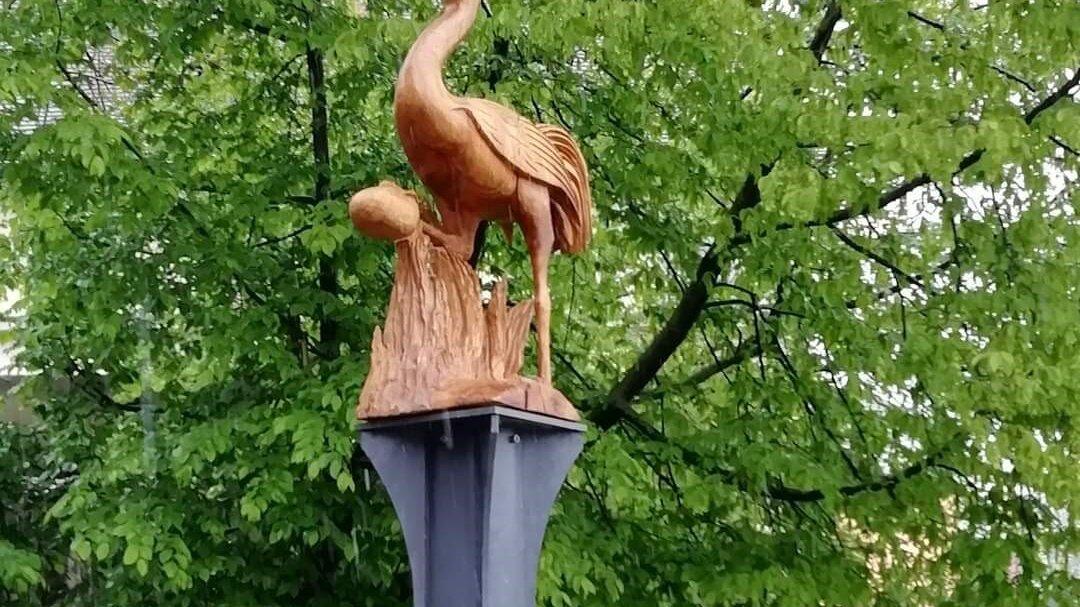District Langenberg
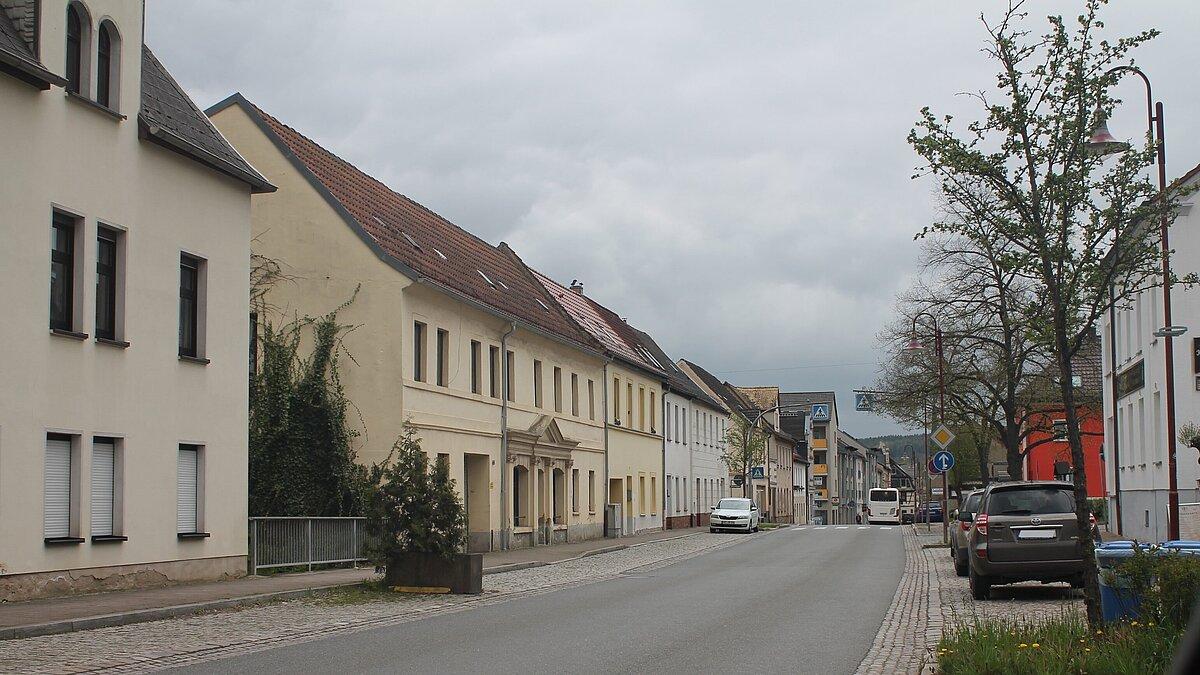
Data and facts
| Name of the district: | Langenberg |
| with the localities: | Langenberg und Stublach |
| Incorporated into the city of Gera: | 26.04.1950 |
| District of the city of Gera since: | 05.05.1995 |
| Surface area: | 262 ha |
| Population: (as at: 31.12.2022) | 3.834 |
Location and transport connections
| Location: | Langenberg is located in the northern part of Gera. It is bordered by the B7, the B2, the "Weiße Elster" and the Gera/Leipzig railroad line. The small-town development stretches along the valley and the slopes. Larger, contiguous wooded areas are located in the northern part. |
| Utilization: | The existing, established locations are small-town in character and reflect the combination of work and residential use in terms of design. The character is increasingly changing into a residential town. |
| Landscape and site design: | Langenberg is characterized by its elongated valley location, which is bordered to the north by a wooded slope. The street structure in Langenberg is urban, while that in the district of Stublach is village-like. There are extensive hiking trails. Langenberg has a striking Evangelical-Lutheran church |
| Transport connections: | Langenberg can be reached via the B2 and the B7, the inner connection is via municipal roads. There is also a stop on the Gera/Leipzig railroad line in Langenberg. Langenberg can be reached by public transport via bus lines 203, 204, 228 and 229 of Regionalverkehr Gera/Land GmbH from the "Duale Hochschule" transfer point. There is also a direct connection to the A 4 federal highway. |
History
History of Langenberg
(Author: Mr. Geiling, Mr. F. Lahn ( U ) and additions to the latest history: Roland Erkenbrecher
Langenberg looks back on an eventful and almost thousand-year-old history.
Originating under the protection of the castle on the local mountain, the town developed rapidly as a German settlement. The name of the village does not come from "long mountain" but is explained by E-P. Kretschmer as a "protective fortified place - the long castle", corresponding to the strikingly narrow and elongated ground plan of the upper castle.
As is so often the case, the origins and decline of the castle are shrouded in the mists of history. Some suspect a fortified military station there as early as the 9th/10th century, from which a stone-built castle, the "Festes Haus", emerged in the 11th century. The different opinions are fueled by the lack of documents from the time of origin. Although Langenberg is mentioned for the first time in a document from 1060, unfortunately this document was not written until the 13th century and consequently there are serious doubts about its authenticity. By writing the document later, the diocese of Naumburg wanted to emphasize its justified or desired ownership claims to Langenberg.
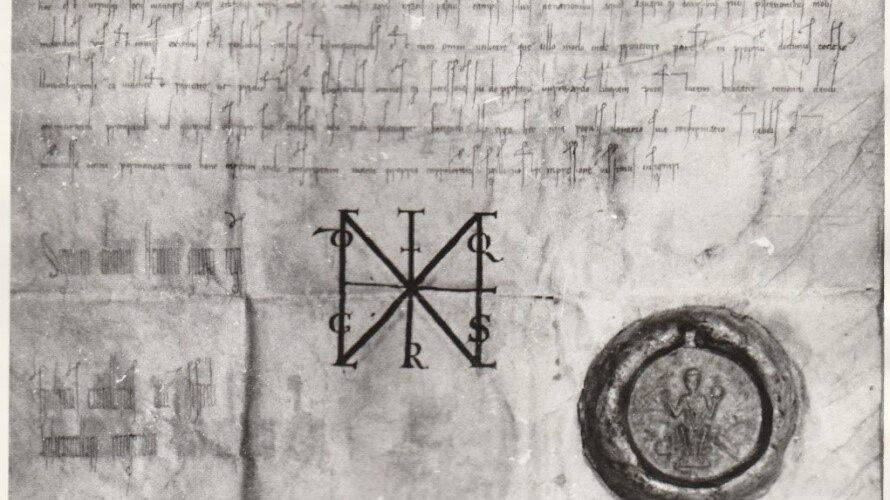
The "Burgwardum Langenberch" had a certain number of "Burgmannen". The center was the castle, to which belonged an outwork, the so-called "lower castle" and after the castle was also called the care.
A document from 1196 mentions, among others, a burgomaster named Thimo de Langenberc and in 1238 the "Castrum Langenberg" with court ban and accessories is listed for the first time in the document of Margrave Henry of Meissen.
The "upper house", the castle, was destroyed in the 15th century, fell into disrepair and from then on served the population and the sovereign as a welcome quarry for the construction of new buildings, including the "Tinz Castle".
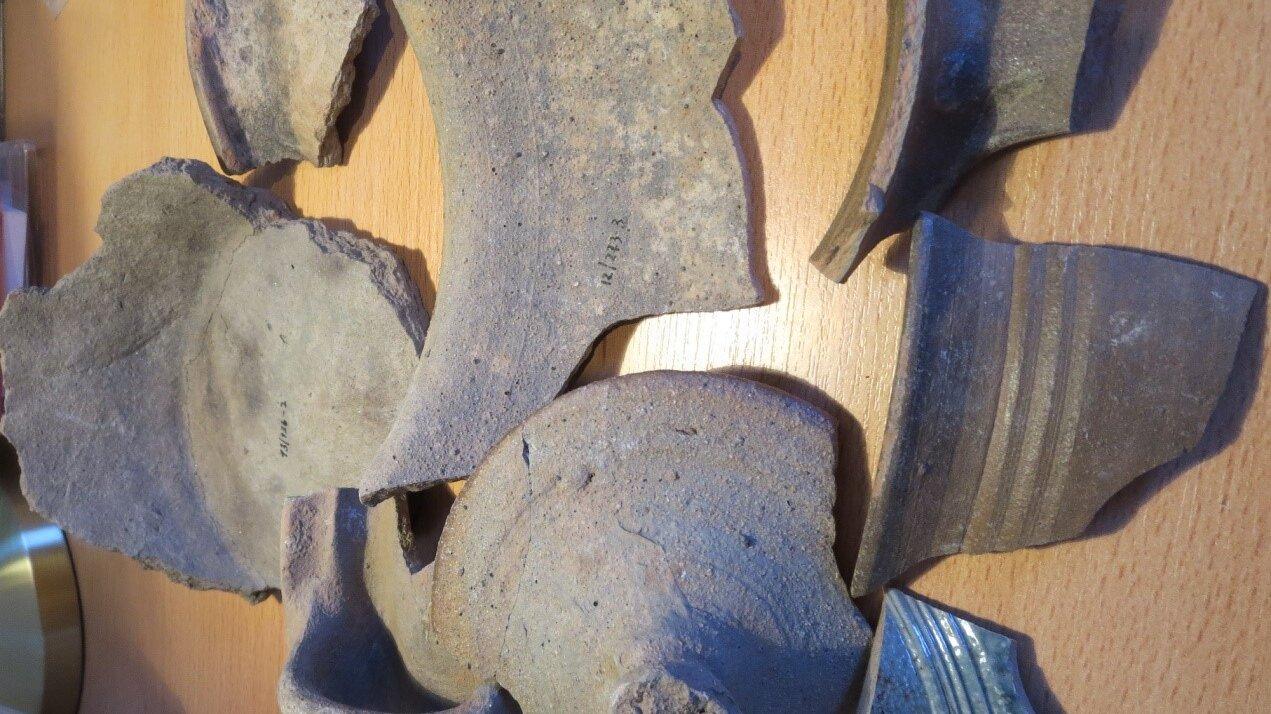
Langenberg must have been a coveted place in the past centuries. It was given away, leased, sold, pledged, appropriated and even a false deed was drawn up for its sake. This finally came to an end in 1502 when Heinricht the Elder of Gera bought the estate and 15 years later had to add a further 4,000 gold guilders to the purchase price of 40,000.
Independence and rights, such as its own judicial district, were lost forever. As compensation, Langenberg was granted a number of municipal privileges in 1505, such as a free gift economy and "free" building rights for every house.
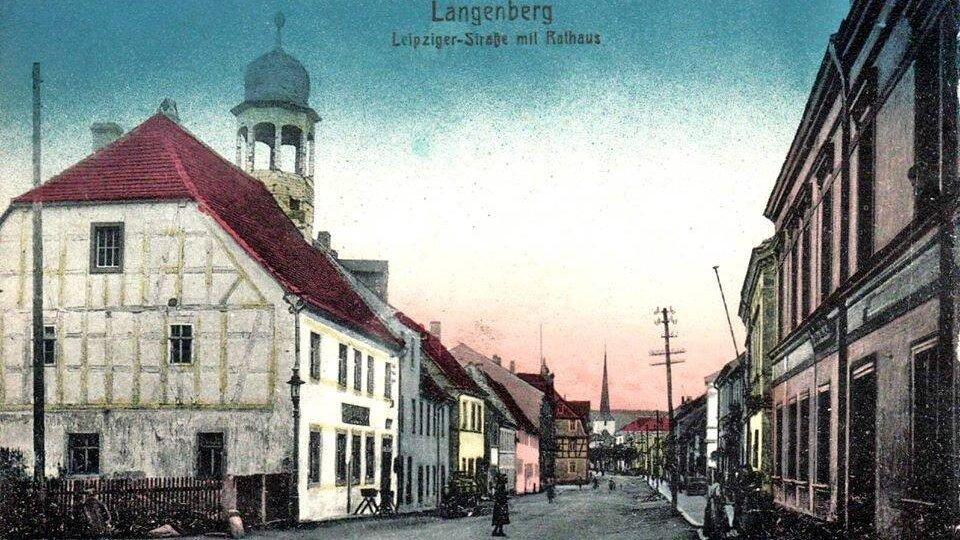
This is also Langenberg's first known documented local law. A castle town was always also a market town. This fact was legalized in 1643 when the sovereign issued the market privilege in a document. After all, a town like this also needs a town hall. Did it already exist around 1500, was the building not completed or even destroyed during the Thirty Years' War? No one can answer this question. After this endless war, which was accompanied by an economic downturn, construction of the town hall is said to have begun in 1647. At that time, Langenberg still had 74 families with 333 souls who had to raise the money for the building.
The building was therefore simple, plain, without ornamentation and decoration; nevertheless, the people of Langenberg were proud of their town hall. However, the year 1647 contradicts the town seal with the year 1645, the inscription Marchfleck Langenberg - and the picture of the town hall with tower. In addition, the wine cellar in the town hall is already mentioned in 1505.
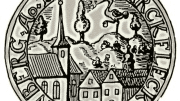
(Kopie 4)
The oldest church in the village was the small castle chapel or Jakobskapelle. It was probably destroyed together with the castle and the outworks in 1430 by the Hussite raids and rebuilt in the 15th century. It was later used for other purposes and demolished in 1920 due to dilapidation.
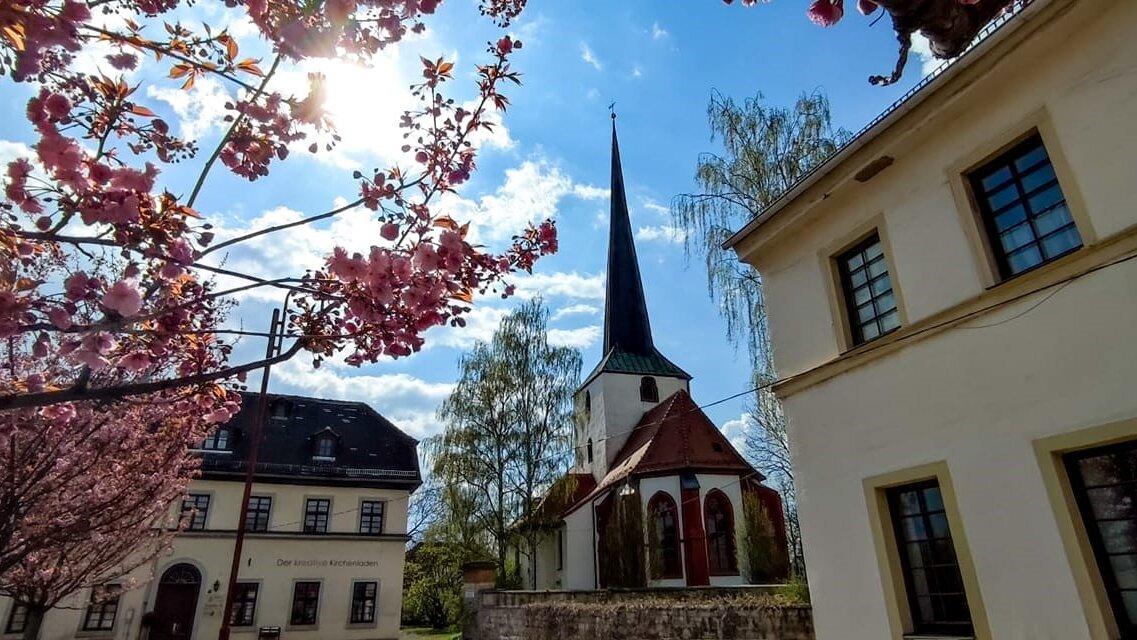
The oldest part of the parish church in the village is Romanesque and already existed in the 13th century. The church received its current appearance through renovations in 1754; the oldest parts date back to the 13th century and the tower was built in 1502. Inside there is an art-historically valuable figural altar, the so-called Fourteen Holy Helpers Altar. Next to the church is the rectory from 1839; previous buildings have been documented since 1323.
Extensions and additions followed. The octagonal tower dates back to 1502 and the church was given its present form in 1754. The artistically valuable carved altar dates back to 1486 and depicts the 14 holy helpers. The church itself is also dedicated to them.
Next to the church is the rectory, which dates back to 1323. This was also rebuilt, extended and reconstructed several times. The current building dates back to 1839. The hospital was another church building. Mentioned as early as 1534, it is clearly older. It was probably a foundation and was located outside the town as a hospital for the infirm in front of the town gate, directly in front of the school.
Langenberg already had a school before 1505, but the teacher is only recorded by name after the Reformation in 1533. Prior to this, the church clerk had also been the teacher here.
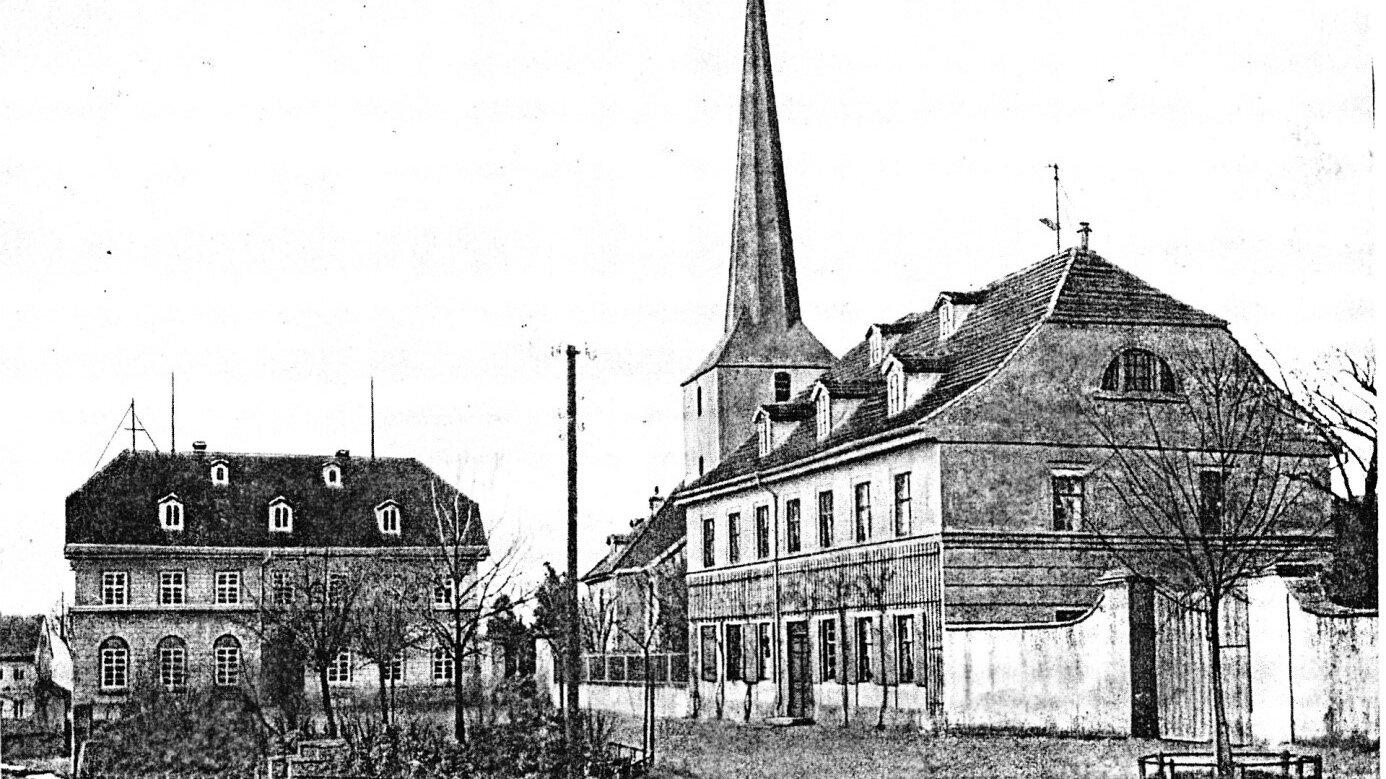
Until 1839, one teacher taught the children of both Langenberg and Stublach. A second teacher was then hired, as the number of pupils had already reached 205.
It should also be mentioned here that Stublach had been "churching, burying and schooling" after Langenberg since the earliest times. Pohlitz and Heinrichshall also belonged to the parish.
From 1615 to 1617, a new schoolhouse was built on the site of the old building. The house still had a thatched roof. A new school building was built in 1838 and a second school in 1887/88, which was extended in 1907. Due to the construction of new housing, the capacity was again quickly exhausted and therefore a new school was built in 1966/68. The school now had 1040 pupils, taught by 48 teachers in 35 classes.
Other public buildings included the parish hall, formerly the shepherd's house, and the baths, which were first mentioned in a document in 1505.
Langenberg suffered in every war. There were constant quarterings, marches, looting and pillaging. The plague also made no attempt to avoid the town and in 1633 as many as 120 victims are mentioned.
The town gained a certain notoriety through the Frontanz. People from near and far gathered at Whitsun, as this is where justice was administered in the old, traditional and well-kept form and manner of speech. Laws, ordinances and the local constitution were read out, citizens were admitted and the front dance also took place. However, it was a dance that had to be danced by those obliged to dance, who had to appear on the market square in Langenberg from the town and the surrounding villages.
There were three other market days in Langenberg, namely the horse market in February and the goods markets (Whitsun and funfair) in May and November.
In terms of crafts, we find cloth and linen weaving, the beginnings of which date back to the 15th century. Although guilds were only permitted in the town of Gera, there was a special regulation for Langenberg. The guilds of coopers, toolmakers and tailors were based here. Beer was also brewed and the people of Langenberg invoked their brewing and donation rights from 1505. The local beer was in demand and often a thorn in the side of the people of Gera.
They wanted to get rid of the troublesome competition and thus triggered a bitter feud that was to drag on for 125 years. Even the priest of Langenberg brewed
.
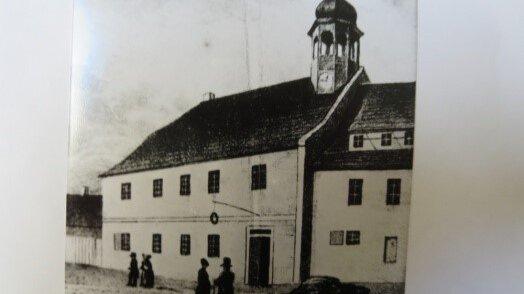
In 1505, the Ratskeller was granted brewing rights as a free tavern.
The hardest stretch of road on the old trade route to Leipzig was the Langenberger Vorspannberg. The wagons had to overcome a gradient of 13% here. The heavy wagons could not manage this without harnessing additional horses. The local horse owners took advantage of this situation, provided harnessing assistance and collected money.
There were also fires in Langenberg and Stublach. In 1592, a total of 47 houses and the vicarage burned down and in 1755, 32 houses on the market square. Stublach burned down completely in 1686 and there was a series of fires here between 1787 and 1802, in addition to a number of other fires. In 1909, the gasworks in Auenstraße, built in 1908, supplied its first gas. The municipality of Langenberg bought the plant in 1920 and operations were discontinued in 1931.
For centuries, Langenberg's water supply was ensured by the springs that emerged in the Rehgrund via wooden pipes and these poured into "six tap water", tubular vats made of stone and wood.
Demand increased around 1900 and so new sources had to be tapped. A pipeline was then laid from Rüdersdorf to Langenberg in 1912/13 and used to feed an elevated tank on the Hausberg.
Fond of the water and swearing by its healing powers, Dr. Blau settled in Langenberg in 1834 and founded a spa business.
He would soon have managed to turn the town into a spa resort. Ignorance and hostility from the ranks of the Gera medical profession spoiled his work and he left Langenberg. For his spa patients, he had built the small wooden "Blue Castle" on the local mountain as a lookout point, a pavilion.
The work of Christoph Gottlieb Steinbeck (1766 - 1818) is closely linked to Langenberg. In 1795, he founded the first Gera newspaper, the "Aufrichtig deutsche Volkszeitung". Pastor Bauer writes: "Not only light, but also a soothing warmth emanated from Langenberg". Steinbeck is not only the father of the Geraer Zeitung, but also the inventor of the train ovens, the so-called Steinbeck'scher Sparofen. He gained further recognition as a popular enlightener. Calendars had a great influence on people at the time, which is why he published a calendar booklet entitled "Der aufrichtige Kalendermann" (The Sincere Calendar Man) in 1792. The success was overwhelming. This was followed by the "Chronological House Calendar" and works on fire prevention and firefighting, such as the "Fire Catechism for the Lower Schools" and other writings.
In the turbulent revolutionary year of 1848, the Landkammerrat C. L . Krause and his co-authored "Langenberg Resolutions" caused a great stir in the small principality.
Bruno Brause, an amateur researcher born in Langenberg in 1893 and well-known beyond the town's borders, was also from Langenberg. He was a keen follower of the natural sciences, and in his work he also devoted himself to the precise surveying of the castle complex on the Hausberg.
In addition to crafts, agriculture, viticulture, fruit growing and market gardening, there were also lime kilns and experiments by Glenck on salt extraction. The first boreholes were drilled as early as 1822.
Langenberg was also affected by the onset of industrialization at the end of the 19th century.
Well-known industrial companies such as the "Erste Reußische Klaviaturenfabrik Raaz", the Gey mechanical weaving mill, the Bufe porcelain factory, the Wilhelm and Otto Spaethe sawmill, the Karl Nitzsche lime works, later the Spaethe company, the Frank butcher's and meat processing plant, later Walter, the Kanis brewery and other medium-sized wood and textile processing and construction companies sprang up like mushrooms and shaped the image of the town from then on.
The settlement was facilitated by the Gera-Zeitz railroad line, which was opened in 1858, and the Langenberg railroad station, which was opened in 1893.
Stublach was incorporated on April 1, 1920 and Langenberg was granted town charter in 1933.
It should not go unmentioned that the Gera airfield was inaugurated in 1926 on Tinzer and Langenberg land. It is curious that the reception building with the airport restaurant and the hangar were located on Langenberg land.
As everywhere else, 1945 was a difficult new beginning. The town had long since passed the 5,000 population mark and 1134 evacuated displaced persons had also found temporary residence here. There is a housing shortage.
The city of Gera wants to grow and is therefore considering incorporations. One candidate is Langenberg. Negotiations begin, promises are made and on July 1, 1950, the brief intermezzo as the town of Langenberg comes to an end.
On July 1, 1950, Langenberg is incorporated into the city of Gera.
After 1945, the private businesses became state-owned enterprises. In the following years, we find the Langenberg piano factory, the concrete factory, the panel factory, meat processing, the "Sero" waste materials trade, a horticultural production cooperative, a sewage treatment plant, the Gera plant, the company vocational school for energy supply and others.
Between 1963 and 1966, the residential areas Reimannstraße and Gebind were built in the typical GDR 4-storey style. This was followed by a large combined children's facility, a large new school building and the Konsum department store opened in 1969.
The reunification completely changes the industrial location of Langenberg. Reprivatization takes place, some businesses are taken over, many are not, new businesses/companies are created. Jobs become scarce. The prefabricated buildings are extensively renovated, new housing estates and houses are built, roads are constructed.
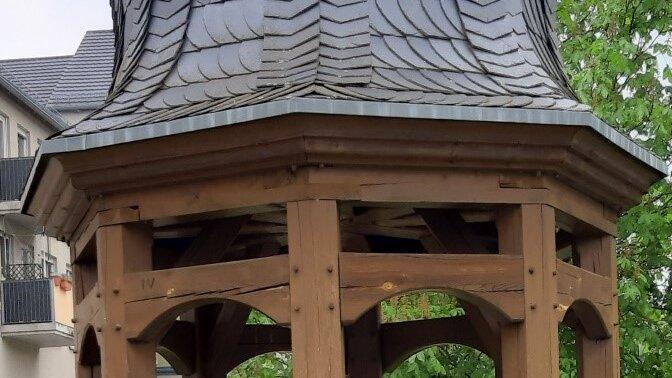
Today, Langenberg is home to a large number of associations. One of these, "Schöner leben in Langenberg" (Living more beautifully in Langenberg), was founded in 1994 and became the "Heimatverein Langenberg e.V." in 1997. Its program includes the development of hiking trails, the installation of benches and tables, signposts, orientation boards, the preservation of local history and much more.
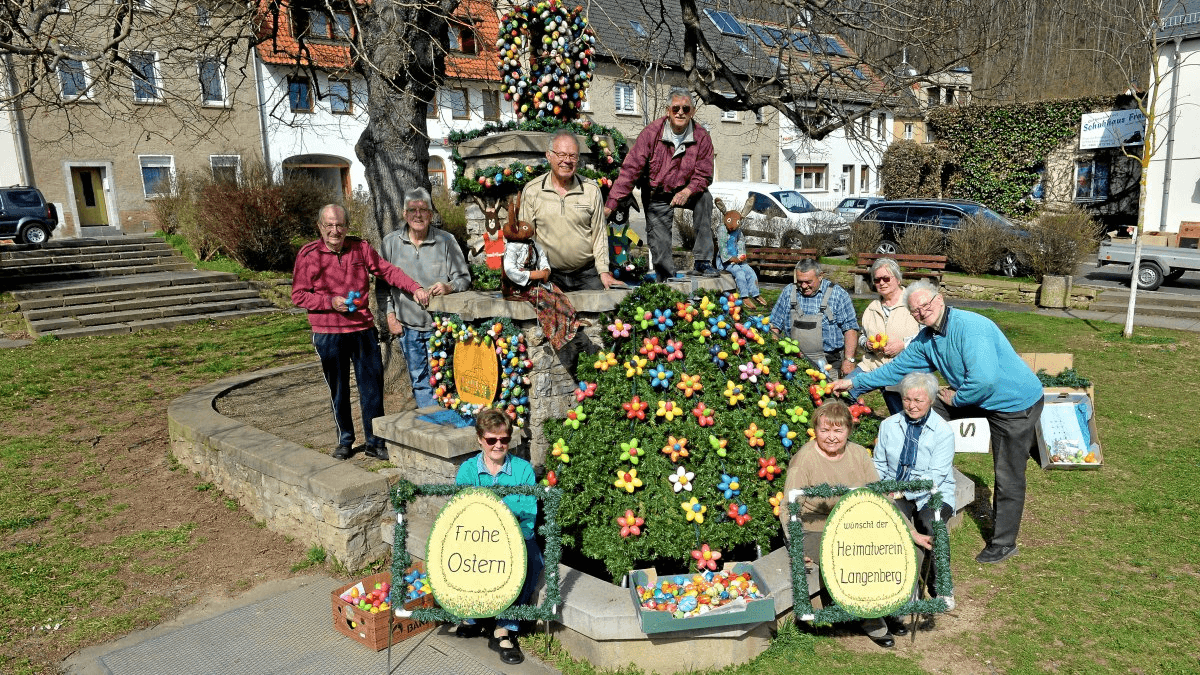
The Langenberg Easter fountain is an eye-catcher in the Gera district.
The privileged shooting club Langenberg e.V., founded in 1822, was re-established in 1995 and in the same year Langenberg was given a local constitution. Franz Lahn was elected mayor and the local council was formed.
The village changed fundamentally in the 19th and 20th centuries. This was due to the construction of the railroad, the highway, the Elster regulation and many other often painful interventions. Nevertheless, Langenberg has retained its charm.
In recent years, the townscape has changed again for the better. Pretty houses, housing estates and much more have been built on the 8.18 km2 area of Langenberg.
There is a lot more to tell about the town and its 4577 inhabitants, about the old and new clubs, about the great sporting traditions, but unfortunately the given framework does not allow it
Astrid Lindgren Primary School Langenberg
In addition to the refurbishment in accordance with the school building guidelines and energy requirements, the school was given a further extension to increase capacity. In this new part of the building, two classrooms, a specialist classroom, a media library and a dining hall with 80 seats were created.
The gym, which was also newly built, is designed so that it can also be used as an auditorium for events.
In June 2013, after four years of construction, the move to the extended and reconstructed school took place. On October 15, 2013, in the year of the 125th anniversary of the old and venerable building, the school was ceremoniously handed over.
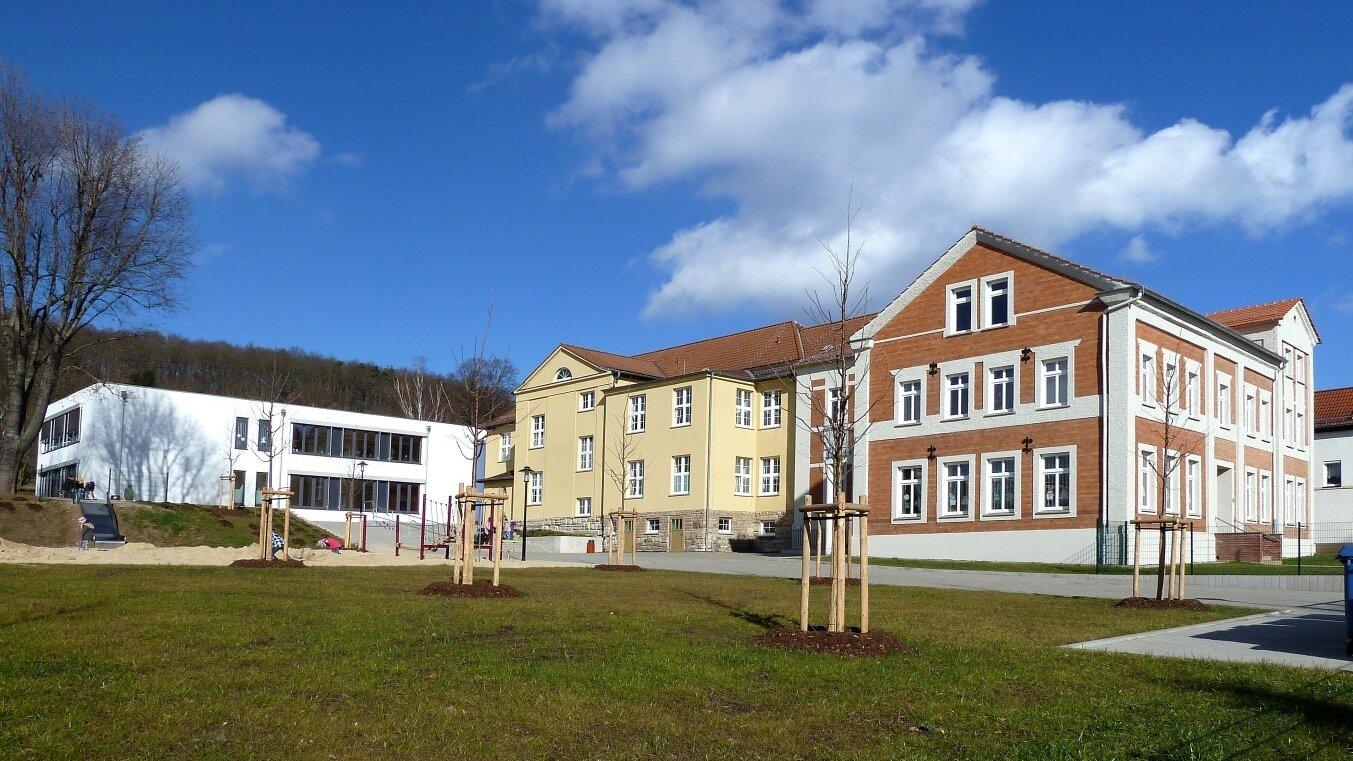
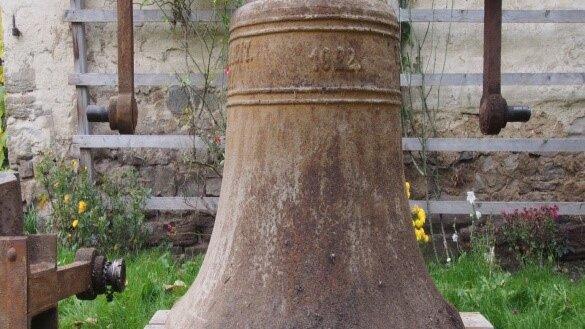
The restoration of the Corylisbrunnen fountain, the construction of a baking oven in the vicarage and the redesign of the Pfarrplatz square by the citizens' initiative "Lebenswertes Langenberg" changed the appearance of the village. Today, a variety of events take place on the parish square: Easter market, festival of lights etc.
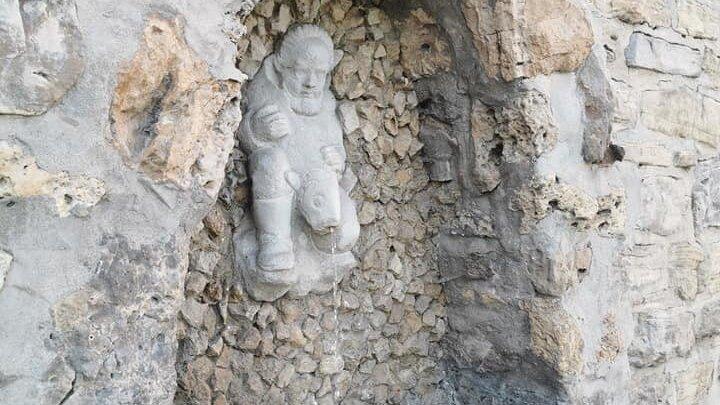
The floods of June 3, 2013 caused enormous damage. Here is a view of the Auenstraße.
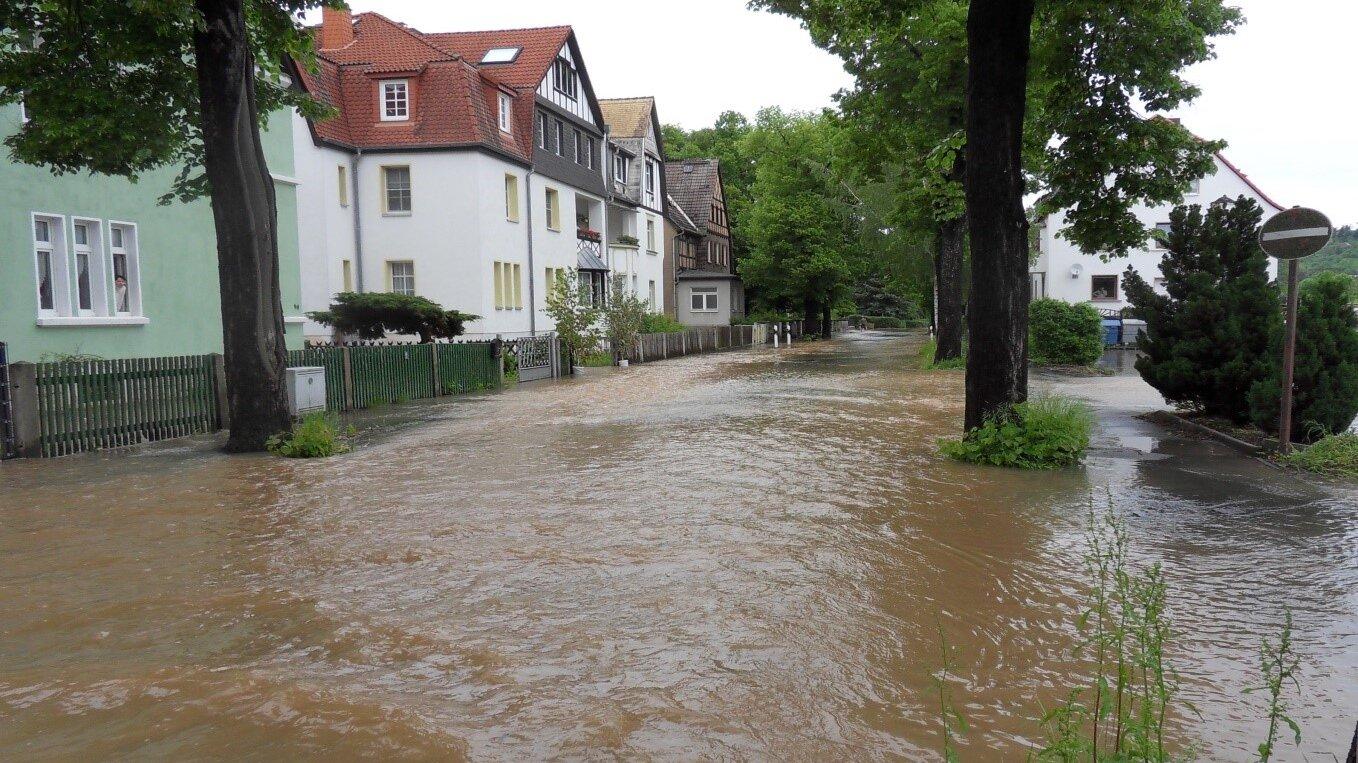
The inauguration of the new district office
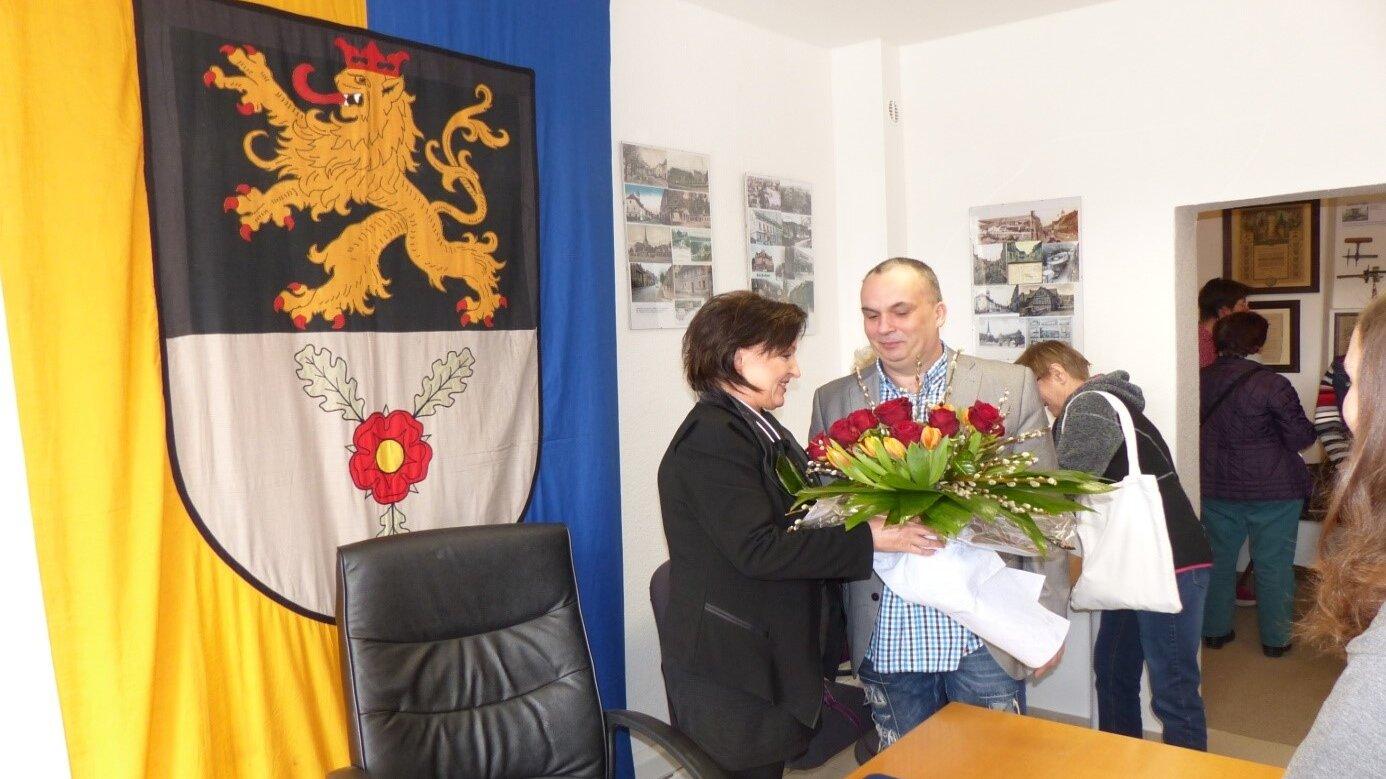
Every year, except during the Corona period, the theater group under the direction of Pastor Andreas Schaller performs a new play, here the "Adventures of Ulysses" and "Martin Luther".
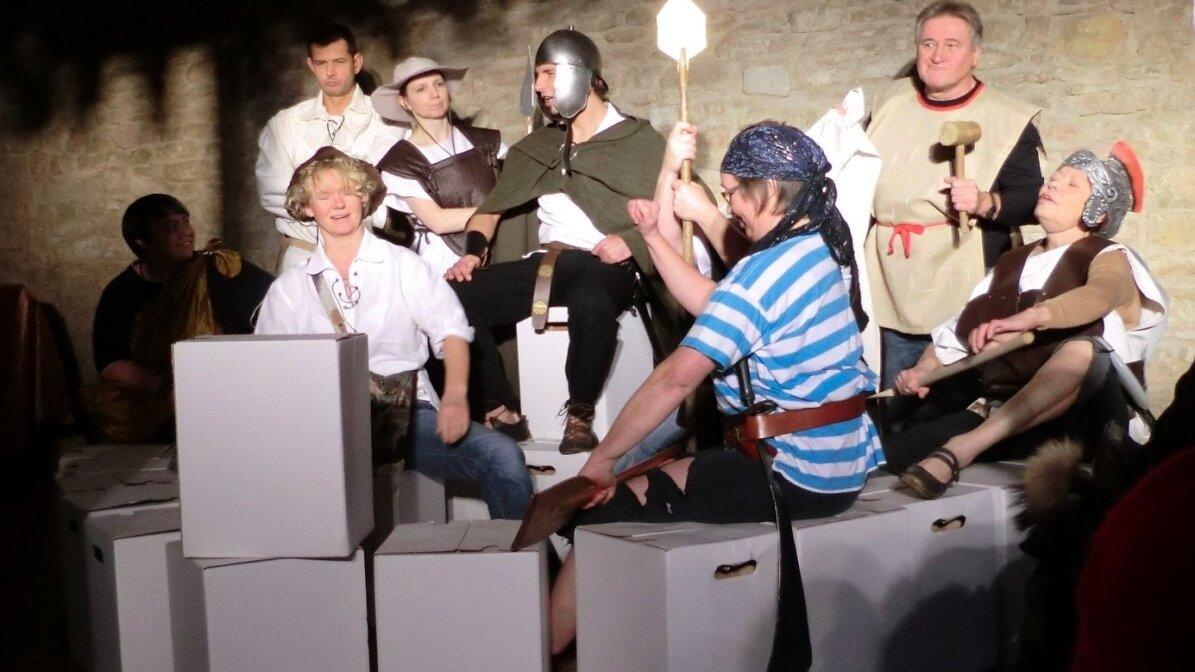
The depiction of the crane from the Langenberg coat of arms was sponsored by Matthias Kirsch (OTB) and erected at the crossroads. Together with the circular flower bed, it is a real eye-catcher.
